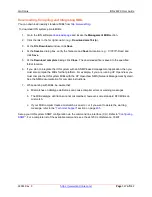
Lantronix
x4120 User Guide
33551 Rev. C
Page
122
of
142
Netstat
Netstat (network statistics) is a command-line tool that displays network connections (both incoming and
outgoing), routing tables, and a number of network interface statistics. It is available on UNIX, Unix-like,
and Windows NT-based operating systems.
The
netstat
tool is used for finding network problems and determining the amount of traffic on the net-
work as a performance measurement. It displays active TCP connections, ports on which the computer is
listening, Ethernet statistics, the IP routing table, IPv4 statistics (for the IP, ICMP, TCP, and UDP proto-
cols), and IPv6 statistics (for the IPv6, ICMPv6, TCP over IPv6, and UDP over IPv6 protocols). When
used without parameters,
netstat
displays active TCP connections.
Note
: parameters used with this command must be prefixed with a hyphen (
-
) and NOT a slash (/):
-a
Displays all active TCP connections and the TCP and UDP ports on which the computer is listening.
-b
Displays the binary (executable) program's name involved in creating each connection or listening
port. (Windows XP, 2003 Server only - not Microsoft Windows 2000 or other non-Windows operating sys-
tems).
-e
Displays Ethernet statistics, such as the number of bytes and packets sent and received.
-f
Displays fully qualified domain names (FQDN) for foreign addresses.(not available under Windows)
-i
Displays network interfaces and their statistics (not available under Windows).
-o
Displays active TCP connections and includes the process ID (PID) for each connection. You can find
the application based on the PID on the Processes tab in Windows Task Manager. This parameter is
available on Windows XP, 2003 Server (but not on Windows 2000).
-p
(Windows): Protocol : Shows connections for the protocol specified by Protocol. In this case, the Proto-
col can be tcp, udp, tcpv6, or udpv6. If this parameter is used with -s to display statistics by protocol, Pro-
tocol can be tcp, udp, icmp, ip, tcpv6, udpv6, icmpv6, or ipv6.
-p
(Linux) Process : Show which processes are using which sockets (you must be root to do this).






























